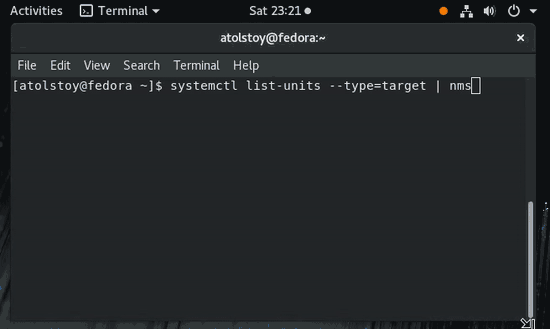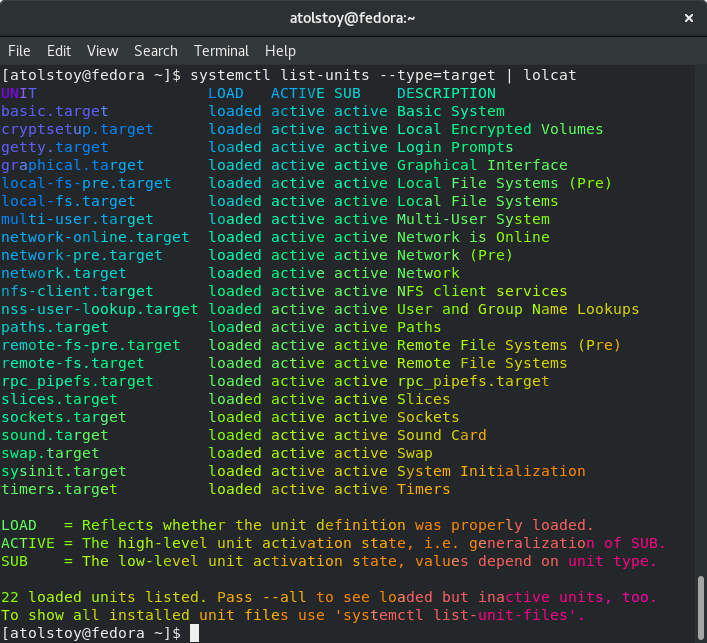Many Linux users think that working in a terminal is either too complex or boring, and try to escape it. Here is a fix, though — four great open source apps for your terminal. They’re fun and easy to use, and may even brighten up your life when you need to spend a time in the command line.
No More Secrets
This is a simple command line tool that recreates the famous data decryption effect seen in the 1992 movie Sneakers. The project lets you compile the nms command, which works with piped data and prints the output in the form of messed characters. Once it does so, you can press any key, and see the live “deciphering” of the output with a cool Hollywood-style effect.

This GIF animation briefly shows the No More Secrets effect
Installation instructions
A fresh Fedora Workstation system already includes everything you need to build No More Secrets from source. Just enter the following command in your terminal:
git clone https://github.com/bartobri/no-more-secrets.git cd ./no-more-secrets make nms make sneakers ## Optional sudo make install
The sneakers command is a little bonus for those who remember the original movie, but the main hero is nms. Use a pipe to redirect any Linux command to nms, like this:
systemctl list-units --type=target | nms
Once the text stops flickering, hit any key to “decrypt” it. The systemctl command above is only an example — you can replace it with virtually anything!
Lolcat
Here’s a command that colorizes the terminal output with rainbows. Nothing can be more useless, but boy, it looks awesome!

Let your Linux command output look jolly!
Installation instructions
Lolcat is a Ruby package available from the official Ruby Gems hosting. So, you’ll need the gem client first:
sudo dnf install -y rubygems
And then install Lolcat itself:
gem install lolcat
Again, use the lolcat command in for piping any other command and enjoy rainbows (and unicorns!) right in your Fedora terminal.
Chafa

Zoom out your terminal view to increase resolution for Chafa
Chafa is a command line image converter and viewer. It helps you enjoy your images without leaving your lovely terminal. The syntax is very straightforward:
chafa /path/to/your/image
You can throw almost any sort of image to Chafa, including JPG, PNG, TIFF, BMP or virtually anything that ImageMagick supports — this is the engine that Chafa uses for parsing input files. The coolest part is that Chafa can also show very smooth and fluid GIF animations right inside your terminal!
Installation instructions
Chafa isn’t packaged for Fedora yet, but it’s quite easy to build it from source. First, get the necessary build dependencies:
sudo dnf install -y autoconf automake libtool gtk-doc glib2-devel ImageMagick-devel
Next, clone the code or download a snapshot from the project’s Github page and cd to the Chafa directory. After that, you’re ready to go:
git clone https://github.com/hpjansson/chafa ./autogen.sh make sudo make install
Large images can take a while to process at the first run, but Chafa caches everything you load with it. Next runs will be nearly instantaneous.
Browsh
Browsh is a fully-fledged web browser for the terminal. It’s more powerful than Lynx and certainly more eye-catching. Browsh launches the Firefox web browser in a headless mode (so that you can’t see it) and connects it with your terminal with the help of special web extension. Therefore, Browsh renders all rich media content just like Firefox, only in a bit pixelated style.

Fedora Magazine still looks awesome in Browsh
Installation instructions
The project provides packages for various Linux distributions, including Fedora. Install it this way:
sudo dnf install -y https://github.com/browsh-org/browsh/releases/download/v1.4.6/browsh_1.4.6_linux_amd64.rpm
After that, launch the browsh command and give it a couple of seconds to load up. Press Ctrl+L to switch focus to the address bar and start browsing the Web like you never did before! Use Ctrl+Q to get back to your terminal.






Aleksandersen
Are anyone working on bringing any of these to the Fedora repositories?
atolstoy
I don’t think so. But you can be the first one if you wish)
xvitaly
Sudo make install? Are you serious? Sudo make install will cause lots of untracked files and cause major problems on updates/upgrades.
This article need to be removed from Fedora Magazine because end users will damage their Fedora installation after using that.
Paul W. Frields
@xvitaly: In both these cases,
installs under the /usr/local hierarchy, which means it shouldn’t be affected by package updates/upgrades. Packaged software in the Fedora repos avoids this folder. It’s not as ideal as packaging, but should be safe for users.
atolstoy
I know that ‘sudo make install’ has long been deprecated, but you’re exaggerating the problem in many ways. First, there is hardly any real issue in installing/upgrading/removing packaged software when you have third-party files in /etc or /usr. You could have thought of such an issue, but it’s not so much probable in real life. Second, the files are prefectly manageable through ‘sudo make uninstall’, which you can try and see yourself.
I’m sorry that you didn’t like the article. Instead of carring out such hasty judgment maybe you could have helped in packaging the aforementioned apps as RPMs in Copr, or may as Flatpaks?
Brenton Horne
I know it’s a minor detail, but the chafa install commands should have a
line after the git clone command and before the autogen script running command.
Bob
It is always frustrating when fun little applications like this are not part of the default repositories. The number of times I have seen someone say “well I can install it with aptitude. ” I’ve had more people switch to Ubuntu because of stupid (but fun) little applications like this than because of all the community and documentation they have combined.
Dmitri
Thanks for fun applications.
lolcat is so fun, I would have to blind my eyes :))))))
BarbaraF
I love it! I usually do a quick check of a bunch of mails with mutt and lolcat adds fun.
me
Terminology. You can have a flying rainbow cat for a cursor and animated transparent backgrounds
atolstoy
Terminology is really great, thanks for the clue. Meanwhile, I was thinking about Alacritty as a testbed for running Browsh inside it. Alacritty is a GPU-accelerated terminal, which pretends to be the fastest one. In my tests, however, it performed fine but not any faster than other terminals.
Dick
https://nyancat.dakko.us/ could easily added to this list.
Enrique Betancourt
Actually I was looking for something like that, but to be honest I stop searching when I found the variety of ‘cows’ in cowsay. Now every time I open my terminal it starts with Rick and Morty and the message ‘Wabba lubba dub dub!!’
Here som cowsay links:
https://github.com/paulkaefer/cowsay-files
https://github.com/bkendzior/cowfiles
How to install:
”’
sudo dnf install cowsay
”’
How to run
cowsay -f [path to a cowsay file] [message]
Miro Hrončok
I’ll try to get chafa to Fedora repos.
judovana
Check https://mojefedora.cz/poberky-z-fedorky/ ‘s console-image-viewer first 😉
Marcin
For those who remember the ancient times, there is a terminal emulating the old monitors from 70’s and 80’s – https://github.com/Swordfish90/cool-retro-term . In the full screen mode it can be very convincing with all the “eye-candy” details from the past . The “funny” thing is that you are not able to use it for real due to the eye discomfort. Good things (such as non-blinking LCDs with high resolution) spoils users :).
The project is already in the Fedora repository. Just type:
Marcin
For those who remember the ancient times, there is a terminal emulating the old monitors from 70’s and 80’s – https://github.com/Swordfish90/cool-retro-term . In the full screen mode it can be very convincing with all the “eye-candy” details from the past (such as the ghosting effect). The “funny” thing is that you are not able to use it for real due to the eye discomfort. Good things (such as non-blinking LCDs with high resolution) spoils users :).
The project is already in the Fedora repository. Just type:
judovana
same as Chafa is:
dnf install console-image-viewer
consoleImageViewer /usr/share/icons/mate/48×48/emotes/face-devilish.png
Is included in fedora repo, but do not know animated gifs.
What it is really good in is that it can list directories and similalry. So searching of images in headless system was never more easy!
First found it at: https://mojefedora.cz/poberky-z-fedorky/ in the middle. (no anchors in document), contains some more examples and screenshots
Alexander Dill
no-more-secrets is in the repository – fedora 28
at least when i do ‘dnf info no-more-secrets’ i get this:
Name: no-more-secrets
Version: 0.3.2
Release: 3.fc28
Arch: x86_64
Größe: 29 k
Quelle: no-more-secrets-0.3.2-3.fc28.src.rpm
Paketquelle: fedora
Zusammenfass: A recreation of the “decrypting text” effect from the 1992 movie sneakers
URL: https://github.com/bartobri/no-more-secrets
Lizenz: GPLv3+
Beschreibung: A tool set to recreate the famous “decrypting text” effect as seen in the 1992 movie Sneakers.
lobocode
Browsh is very crazy lol!!!